Ethiopian Coffee Brands
Ethiopia has been a a growing market in the coffee bean business, putting forth many Ethiopian coffee brands.
The most productive and popular brands of Ethiopian coffee beans are grown in four primary regions.
Ethiopia as a country has decided to market each region as a separate product. The result is that the regional names are becoming more recognizable than the country for their specific coffee bean characteristics.
Do You Want the BEST Ethiopian Coffee Brand?
Regions
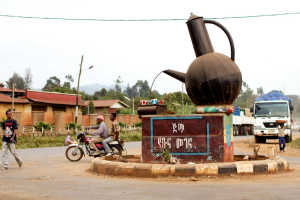
“IMG_1976” by Stijn Debrouwere, via Flickr (CC BY 2.0)
These four regions of Ethiopia are the primary coffee bean growing regions.
Each are marketed separately as their own Ethiopian coffee brands:
- Harrar
- Limu
- Sidamo
- Yirgacheffe
I personally see Yirgacheffe coffee beans everywhere when looking for Ethiopian coffee brands. I see them on coffee bean forums, in grocery stores, talking to friends, etc.
So, while researching Ethiopian coffee beans for this article, I estimate that I see Yirgacheffe as a brand more often than three region brands combined.
Harrar Coffee Beans
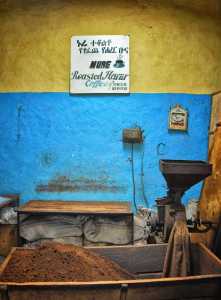
“Harar Coffee, Ethiopia” by Rod Waddington, via Flickr (CC BY-SA 2.0)
Harrar is located in central Ethiopia towards the eastern borders. Sometimes it is spelled Harrar, Harari, Harer, or Harar. One of the more known coffee bean varieties is Moka Harrar.
One of the more unique characteristics of Harrar is the old City Wall of Harrar that was built between the 13th and 16th centuries.
The city of Harrar is considered to be the fourth oldest city in the region behind Mecca, Medina and Jerusalem.
Harrar has been a strong Muslim city for centuries. Many early leaders of Harrar were proponents of Jihad and attempted to snuff out Christian cities in the region.
Even though Harrer has strong Muslim heritage, most of Ethiopia has a strong Christian culture.
Coffee beans from Harrar are often laid out to dry in the sun, fruit and all. This causes the fruit to bake the coffee beans leaving a wild, somewhat fruity and overly sweet taste.
Coffee beans that are left to dry for longer periods of time end up having a mild fermented aftertaste.
The farmers of Harrar like to market this taste as a “mocha” flavor. Although, many in the coffee world find this a very misleading description. Many describe Harrar coffee beans as being distinctively fruity, with a wine-like flavor.
Limu Coffee Beans
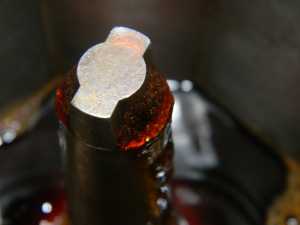
“Bubbling Limu” by Joe’s Famous Coffee, via Flickr (CC BY 2.0)
In Limu Ethiopia, coffee beans that are harvested are then washed or what is called wet processing.
Wet processing involves soaking the coffee bean fruit in water for long enough to soften the fruit layer of the coffee bean.
The softened fruit is then processed using a pulping machine to shuck the coffee beans from the coffee bean cherry.
Once separated from the cherry, the cherry seeds (the coffee beans) are often places in a separate fermentation tank for 8 to 24 hours. The purpose of the fermentation tank is to remove the mucilage or glue like substance that encases the coffee bean seeds inside the coffee cherry fruit.
After the coffee beans have been completely separated from the cherry fruit, they are typically sun dried or machine dried.
The coffee beans used in the “Limu” wet process are hand selected and end up being higher quality.
The Limu coffee beans are typically soft from the wet processing. Limu coffee plants produce a round bean.
The taste is almost flowery with hints of citrus. But, the Limu coffee bean ends up less fragrant than its counterparts from other regions in Ethiopia.
Sidamo Coffee Beans
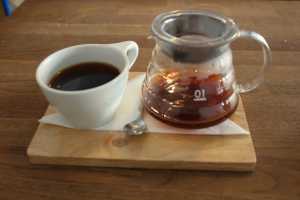
“Ethiopian Sidamo Aeropress at Quarter Horse” by Bex Walton, via Flickr (CC BY 2.0)
The southern region of Ethiopia hosts a multitude of coffee bean plantations.
Being from the Sidamo region, these coffee beans have their own distinct flavor.
The farmers in Sidamo also typically follow similar washing procedures as is performed in Limu.
Sidamo coffee beans are Arabica. In fact, Ethiopia is often considered the place where all Arabica coffee beans were born.
Sidamo can lay a significant claim as the source of all coffee!
Sidamo coffee beans provide a rich, deep flavor with hints of spice and wine. Sometimes a chocolate-like note can be identified. And, the aroma found is very flowery.
Yirgacheffe Coffee Beans
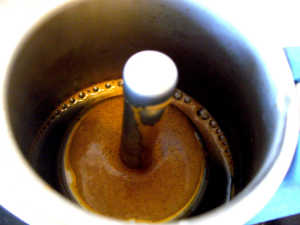
“Yirgacheffe in my Bialetti” by Peter Lindberg, via Flickr (CC BY 2.0)
Yirgacheffe is sometimes spelled Irgachefe, Yirgachefe, Yergacheffe, or Yerga Chefe.
We are going with Yirgacheffe because most coffee bean brands have chosen this spelling in their brand name.
Also, Google asks if you meant “Did you mean: Yirgacheffe” if you type any of the other spellings into the search engine.
Location-wise, Yirgacheffe is deep within the Sidamo region. So, if Sidamo is the heartland of Arabica coffee beans, Yirgacheffe should be considered the heart.
Yirgacheffe coffee beans are grown at an elevation of just a little over 6,000 feet.
The high quality of these Yirgacheffe coffee beans caused others looking to capitalize on this farming recipe to look for similar elevations. Many exported Arabica to these other location (many in South America) in search for similar success.
They were very successful with this strategy.
Wet processing is also one of the hallmarks of Yirgacheffe Ethiopian coffee brands. The “washing” gives these coffee beans a “cleanness” and “crispness” that you often don’t find in other coffee bean brands.
Best Ethiopian Coffee Brands
Now that we’ve talked about the top coffee bean growing regions and some of the characteristics of each, we reveal our findings for the best Ethiopian coffee brands from each region.
Best Harrar Coffee Brand
Our research led us to this Harrar coffee bean as the top coffee bean product using the “Harrar” brand name.
Koffee Kult Ethiopian Harrar Whole Bean Coffee
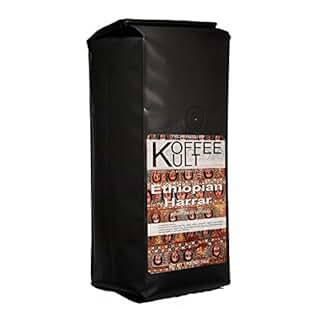
[wpi_designer_button text='GET IT NOW' link='/internal/KoffeeKultEthiopianHarrarCoffee' style_id='586' icon='digg' target='_blank']
This Harrar coffee bean can be described as having blueberry notes, with smooth dark chocolate undertones.
Its body is considered balanced or sometimes full.
These beans are considered “medium” roasted by Koffee Kult. Many describe these “medium” beans to be towards the darker side of “medium”.
Best Limu Coffee Brand
For the best Limu Ethiopian coffee brands, we selected this gourmet product from Ajuvo World Market.
Ajuvo World Market Ethiopian Limu Roasted Coffee Beans

[wpi_designer_button text='GET AJUVO' link='/internal/AjuvoWorldMarketEthiopianLimuCoffeeBeans' style_id='586' icon='digg' target='_blank']
They participate in Fair Trade with the Oromo Coffee Farmers Cooperative Union.
The fruity and spicy undertones of this coffee bean occur because these coffee beans are grown next to bananas, cinnamon and tea plantations.
This unique growing experience gives these Limu coffee beans an extraordinary taste that can only be described as gourmet.
Best Sidamo Coffee Brand
With Yirgacheffe being part of Sidamo, it was a little difficult finding “Sidamo” Ethiopian coffee brands that weren’t from Yirgacheffe.
But, we think of all the Sidamo Ethiopian coffee brands, this one from Wild Foods hits all of the markers your looking for in a top notch coffee bean.
Wild Coffee Whole Bean Organic Coffee Sidamo Medium Roast

[wpi_designer_button text='GET WILD' link='/internal/WildCoffeeWholeBeanOrganicCoffeeSidamoMediumRoast' style_id='586' icon='digg' target='_blank']
They adhere to fair trade practices and are Fair Trade certified.
The buy from Ethiopian farmers that grow their beans organically.
Wild Foods calls these coffee beans a “medium” roast. You might find these beans to be on the “darker” side of medium.
From a taste perspective, it has a deep rich body. And, you can definitely sense notes of chocolate, with floral hints and a touch of spice.
Best Yirgacheffe Coffee Brand
We had to go with wet processed for the best Yirgacheffe coffee bean brand.
And, this coffee bean from RhoadesRoast Coffees met all of the criteria.
Ethiopian Yirgacheffe Washed Grade 1 Unroasted Coffee Beans

[wpi_designer_button text='YEARN FOR YIRGACHEFFE' link='/internal/EthiopianYirgacheffeWashedGrade1UnroastedCoffeeBeans' style_id='586' icon='digg' target='_blank']
Washed in this case means wet processed like we discussed above. This process is what gives these beans such a clean flavor.
If you roast these beans to a medium or even City roast, you’ll get a smooth medium body. This results in a very nice finish.
Several customers bragged about roasting these beans to a medium to dark roast, and how well these beans worked when prepared as espresso.
These beans provide a low acidic mixture with a high caffeine kick!
Related Articles
Read more information about coffee beans and where they grow in this article about coffee bean locations.
4 Responses to “Ethiopian Coffee Brands”
Sorry, the comment form is closed at this time.
i would like to have more info about the type of coffee bean as i see there is 4 type of them
please get me the prices per tone in USD cif to Ukraine & gulf regent
thaks BADER
Badar,
Thank you for your interest.
However, I don’t sell coffee beans by the ton. If you click on the various coffee bean I recommend, they will take you to a page that shows you the price. Let me know if you have any problems with that.
Regards,
Thank you very much for your blog.
I enjoyed reading this article.
Milana,
Thank you! I’d love to hear any great coffee bean experiences you’ve had.
Regards,
Emily